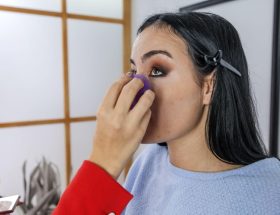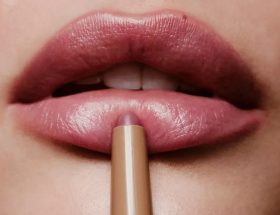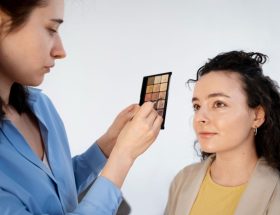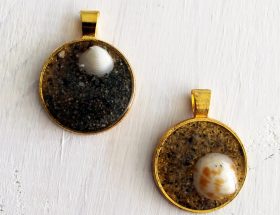A good foundation is the key to a radiant and smooth makeup look. The right color, type, and texture enhance your appearance, while the wrong one can lead to a cakey finish, dryness, or breakouts. So, here’s what to look for when choosing the perfect foundation for your skin type.
Basic Foundation Knowledge
Foundation is a cosmetic product used as a base for makeup. It comes in liquid, powder, cream, or stick form and helps hide imperfections, even skin tone, and provide a smooth finish. Foundations also protect your skin and offer extra benefits like hydration, oil control, or sun protection. The right one can transform your entire look.
Step 1: Know Your Skin Type
Knowing your skin type is essential because each type has specific needs. Matching your foundation to your skin type helps it wear better and last longer.
-
Normal Skin: Balanced texture. Use any foundation type for a natural glow. Hydrating foundations give a dewy, satin effect, and lightweight, buildable formulas let you control coverage.
-
Oily Skin: Shiny, especially in the T-zone. Use an oil-free mattifying foundation to control shine. Look for labels like “oil-free” or “matte.” Powder or liquid foundations that absorb oils are great.
-
Dry Skin: Tight, scaly. Fine lines and texture are more prominent. Use a moisturizing foundation to smooth out dryness. Hydrating foundations with hyaluronic acid or glycerin give a smooth, fresh, slightly dewy or satin-textured look.
-
Combination Skin: Oily T-zone, dry cheeks. It’s challenging to find the right foundation since it has to balance the needs for both sections. Good foundations control oil without drying the skin. Look for multi-purpose and buildable foundations that are neither too matte nor too hydrating for easy application on both oily and dry areas.
-
Sensitive Skin: Prone to redness and irritation. Use a non-comedogenic formula without fragrance, parabens, or harsh chemicals. The foundation should have soothing properties from ingredients like aloe vera, chamomile, or calendula. Mineral foundations are non-toxic, moisturizing, and light, which do not cause irritation to sensitive skin.
Step 2: Determine Your Skin Tone and Undertone
Determine your skin tone and undertone to find a proper foundation color that blends easily into your skin.
-
Skin Tone: Gives an overview of the shade of your skin. There are three broad categories: Fair (very pale and burns easily with pink and neutral undertones), Medium (generally olive-colored, in a short period may tan, but usually has yellow or neutral undertones), and Deep (deep and rich tones, but sometimes have reddish, bluish, or golden undertones). When selecting a foundation, choose the closest shade to your natural color. Try foundation shades around the jawline or neck and check how the shade mixes with your natural undertones.
-
Undertones: Lighter colors that exist beneath the visible color of the skin and determine what foundation will look like on the skin. There are three types: Cool undertones (pink, red, or blue tones, then get a foundation whose base tone is pink or blue), Warm undertones (yellow, golden and peach tone, then the base of the ideal foundation is therefore yellow or golden), and Neutral undertones (equal ratio of warm and cool tones, then you can wear either yellow or pink base foundation).
-
How to Determine Your Undertone: Vein test (if the veins of your wrist are bluish or purplish, then you most probably have cool-toned, if they look to have some greenish tinge to them, then you probably should have warm undertones, and if they are a mix of that blue and that green color, you most probably have neutral undertones) and Jewelry test (determine which you look more beautiful in silver and gold jewelry, if silver complements the undertones of your skin color, if you have cool undertones, but if gold complements you better, then you must have warm undertones, and if both look good on you, then you must have neutral undertones).
Step 3: Select the Correct Foundation Type
Foundations are available in many forms, and each offers a different finish and coverage.
-
Liquid Foundation: Versatile and can be used for almost any skin type. They come in different finishes, like matte, dewy, and satin. Liquid foundations are medium to full coverage that can be layered to give an enhanced finish. For oily skin, use a matte finish liquid foundation that helps regulate shine, but for dry skin, choose a hydrating liquid foundation with a dewy finish.
-
Powder Foundation: A great base to achieve a light, natural look or for oily skin. They can be buildable with a brush from moderate to higher coverage. Because they apply so well, it’s perfect for quicker makeup application on a busy morning. If your skin is dry, apply a hydrating primer or moisturizer, so your skin does not flake or patch up and becomes powdered foundation.
-
Cream Foundation: Full coverage, cream foundations are provided with rich texture and come in smooth. Creams can be applied either on normal skin or dry skin. These are provided with moisturizing qualities along with that dewy finish. To the one who needs an increased level of coverage beyond what daily application conceals blemishes, dark circles, and discoloration, they shall appreciate cream foundations. Apply the cream foundation using a makeup sponge or foundation brush for that flawless airbrushed look.
-
Stick Foundation: Portable and provides medium to full coverage. They can be used for touch-ups on the go and produce a natural matte finish. Compared to powder foundations, stick foundations are more moisturizing but heavier than liquid foundations. Sticking foundation suits best for combination and oily skin, but in case of applying the same to dry skin, hydrate the face prior.
-
Mineral Foundation: Suitable for sensitive or acne-prone skin. Mineral foundations, with ingredients like zinc oxide and titanium dioxide, are based on natural elements. Mineral foundations make sure that it does not too harsh on the skin with buildable coverage. In addition to this, it is also good for sun protection and provides a matte finish. Mineral foundations are perfect for light to medium coverage, so apply with a fluffy brush for an airbrushed, natural finish.
Step 4: Test the Base
Testing different shades and types of foundation is part of the process in finding the right one for your skin. Here’s how to test foundation: Try it on your jawline or neck (test foundation shades on your jawline or neck rather than your wrist or hand since skin that belongs to the hands, including the wrists will almost always be different tones compared to the skin on your face, and this is typically where the jawline meshes with the rest of the body), Let the foundation set (apply a little amount of this foundation on the skin and dry it up for a while, then, you will know how it would turn out once the foundation oxidizes, mixing with the natural oil in your face), and Check in Natural Light (inspect foundation always in daylight. Artificial light tends to distort color and often means a foundation will look different than it might when viewed by the naked eye in natural light. Look outside or next to window how it looks in the daylight).
Step 5: Final Tips to Choose Best Foundation
Know your coverage needs (determine how much coverage you need. If you want a light, natural finish, you will look for a sheer or light-coverage foundation, but for more coverage, you will look for medium to full-coverage foundations), Think about your skin’s needs (if you have acne, redness, wrinkles, or any other problem, you would want a foundation that has some skincare benefits in it, such as anti-acne ingredients, SPF, or anti-aging ingredients), and Always Blend (the secret to perfect finish is blending, use proper tools, like sponges, brushes, or even your fingers, which can melt the foundation into the skin).
Conclusion
Choosing a good foundation is very subjective as its application depends on the person’s type of skin, tone, undertone, and choice of coverage. If you understand your skin, take my advice, and follow my tips on the perfect foundation, it gives you the best foundation to enhance your natural beauty, and there would surely be no going back. The right foundation will cover all those minute flaws and boost your confidence within to be the best version of you.













